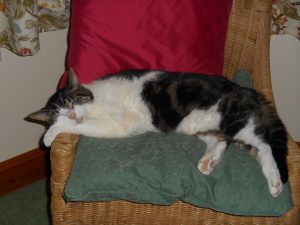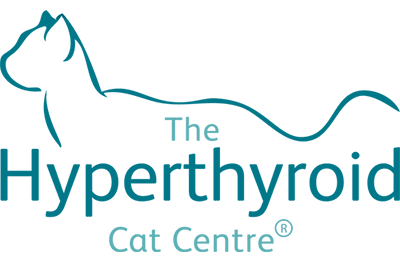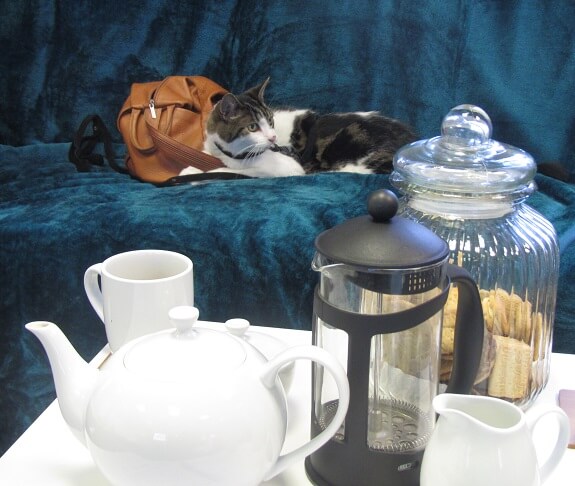We named our little white/ tabby cat Mouse because of the enormous pink nose and gigantic white whiskers which dominated her tiny kitten body. She became part of a rescue cat household totalling 5 and was fit and healthy for 14 years. In fact she outlived them all and became known as “last cat standing”.
My husband and I retired 5 years ago and the three of us spent a lot of time together.
However, it was only when Mouse began licking water from the patio furniture that we realized that her gross appetite, pickiness and restlessness were not just a consequence of old age. Blood tests confirmed Hyperthyroidism, increasingly common in elderly, especially female cats, apparently. Our vet explained our options: special diet, remove the palpable lump on her neck, a lifetime of tablets or Radio Iodine treatment.
She had never eaten dry food or taken tablets and the Radio Iodine seemed a bit “Space Age”, so we opted for the operation. The operation went well, but sadly the Hyperthyroidism persisted. With no obvious tumour our vet said a second operation was not an option. So we looked into Radio Iodine Treatment via the Internet and as always with this handy tool, learned far more than we ever wanted or needed to know about this treatment and Radio Activity in general.
It was alarming and reassuring in equal measure. Everyone referred to it as “The Gold Standard” of the treatment options with no real side effects The only drawback appeared to be the price (£1800 -£2000 at the time) and the limited number of clinics offering the treatment, only 7 in the UK.

Mouse having a nap
Despite Mouse being uninsured and us being OAPs on a fixed income, we were lucky enough to be able to finance the treatment, which we calculated was no more than the Far East Holiday we had been considering. In fact, if the cost of lifetime medication ( £ ) or operations and blood tests (£ ) is taken into account, the additional cost was well worth it, considering it was a single shot, painless treatment for the cat …. and for us! Our main concern was the fact that the nearest Radio Iodine Treatment Centre was over 200 miles away and also that most centres required a 2 week stay in isolation.
We knew that Mouse could easily survive a fortnight without us (we happily leave her for weeks at a time with a kindly housesitter) but we did worry about the shock of being caged, afraid and isolated for an elderly cat with no previous experience of kennels or hospitalisation. We were immediately attracted to The Hyperthyroid Cat Centre in Wetherby which offered a possible 1 week stay and had a very user- friendly Website.
What was confusing was why this appeared to be the only UK centre offering to return cats after one instead of two weeks. Weren’t the Regulations National? Were they being Maverick or the others super cautious ? Who was the regulating body? What influenced the decision? How come America and Belgium allow cats home after 4 days?
We had quite enough stress and worry about doing the best for our animal, without having to decide who to believe on this question. If we were going to expose ourselves to any radioactivity risk, then we wanted to see some data to understand and weigh up the risk we were taking. Happy to follow the guidelines but, given conflicting advice, we wanted to be able assess our own risk for ourselves.
Unfortunately, the available information on doses and half-life etc was too technical and dense to make much sense of and to gauge how it might apply in our circumstances.
We were getting totally divergent responses from friends concerned about our Moggy. Some (mainly non pet owners) thought we were quite mad to think of exposing ourselves to any radioactivity risk, let alone
driving hundreds of miles and paying over a thousand pounds for an elderly animal. Others said they would do the same for their own pets, but even they were alarmed at the idea of introducing Radioactivity into the house!
A hugely reassuring resource turned out to be my brother, recently retired as Fire Chief for a large Southern County. He had dealt with Hazardous Substances his whole career and was able to explain about Half Life and the Inverse Square Law We were amazed to learn just how much background radioactivity there is from natural sources around us every day. He even tried to get hold of a Geiger counter so we could sweep the house before inviting friends to stay over.
Eventually we came to a much better understanding of the situation, thanks in large part to the time, patience and reassurance Andrew Bodey, the Vet at the Hyperthyroid Centre was prepared to give us! We did contact some other places who carry out the procedure but they did not offer the same access or friendly, personal contact. One great advantage of the Hyperactive Cat Centre in Wetherby was the friendliness and knowledgeability of the whole team and the individual focus on each animal they offer.
Even after reading the detailed Patient Guidelines you find yourself left with lots of questions, some dafter than others! How big are the kennels? Does the treatment hurt? Do they have the radio on? Can they see other cats? Why is it safe for other pets and not people?
Having persevered with 2 weeks of oral medication (happily using guile and not resorting to brute force…. Philadelphia Cream Cheese is a lifesaver!) Mouse was tested and deemed suitable for Radio Iodine Treatment.
We had daily “car practice” driving to the local shops to familiarize her with the inside of the car and prove it didn’t always land her at the vet, before setting out on our 275 mile journey.
It went remarkably well. Mouse didn’t object to a specially purchased harness and sat on the back seat, either in her favourite bed or my lap.
Leaving her at the Centre was predictably dreadful because you always feel you have betrayed their trust!! She had her familiar bedding and favourite scratch pad, but we knew she would hate incarceration, being a sociable little soul.
Normally the weeks whiz by and we wonder how can it be Friday already, but that week the clock seemed to stop somehow. Spookily, we used to hear what sounded like her sharpening her claws on the carpet (a big no no) and her footsteps on the landing, even though we knew she was hundreds of miles away!
We had twice daily phone bulletins from Joanna the Vet Nurse who worked really hard to make Mouse’s stay as painless and short as possible. The detailed reports and the photos Joanna gave us were extremely helpful. Unfortunately Mouse ate virtually nothing for a few days post injection and this contributed to her staying a couple of extra days.
She was ready for discharge on day 9 and we set off with her in a crate (specially designed by my husband) in the back of the hatchback. The journey seemed interminable, but in fact took four and a half hours, with short comfort stops to show her we were still there! Mouse yowled pitifully the whole way which left her with a tiny croak of a meow –and she such a very chatty cat!
She was disorientated and a bit frail at first but soon got back into her former patterns.
Fortunately Mouse is a bit more dog than cat in many ways She rarely goes out of sight of the house when in the garden and will even come when called!!.She has never been a lap cat and her natural instinct is to stay companionably a metre or so from us, unless she wants something! So keeping our distance and using minimum constraint for her, was relatively easy. We were able to sit out on the patio in the sun with her,
knowing she would not stray. A quiet household with no other pets or family, was ideal for post Iodine Treatment.
In Summary
- If we were to summarise our whole adventure with Feline Hyperthyroidism the following would be our key observations.
- Be alert for symptoms of Hyperthyroidism in your cat especially if elderly and female
- Untreated, it is life threatening and unpleasant for the cat and you. Treated it doubles life expectancy
- Check out all the options carefully. Don’t be put off Radio Iodine by the cost. Compare it with other long term treatment costs
- If opting for Radio Iodine Treatment, try to find a Centre which treats your cat as an individual, works in tandem with your regular vet and importantly, discharges the cat as quickly as is safely possible after treatment. It is obvious that pets will be less stressed and recover better in their own home setting, especially those unused to kennels.
- Don’t be frightened by the word Radioactivity. It’s useful to know that there are constant background levels of radiation all around us, and that long haul flights and X Rays pose similar hazards without any obvious public alarm.
- It would have helped us greatly to have had more user friendly data and more hard facts about Radioactivity, what it is and how it behaves, plus the average doses given to cats etc.
- Pictures of the kennels would have been reassuring; imagining them all alone in a tiny box doesn’t help!
- Make sure your cat has her favourite food ,bedding and toys to speed up the recovery process.
- It would have helped if local Vets had had more knowledge of the Radio Iodine Treatment, and had known about the possibility of discharge after 7 days.
It is now nearly a month since the treatment and Mouse has regained weight, her glossy coat and her chirpy nature. She still hasn’t got her voice back …. possibly a mixed blessing!
It is wonderful to have her back on form and with hopefully some good years ahead of her.
We are so relieved not to have to administer twice daily pills for the rest of her life. It can totally ruin your relationship with your cat!
We are eternally grateful to Andrew Bodey and the whole team in Wetherby for all they did for our cat and for all the help they gave us navigating through this whole eventful journey.
We are eternally grateful to Andrew Bodey and the whole team in Wetherby for all they did for our cat and for all the help they gave us navigating through this whole eventful journey.



